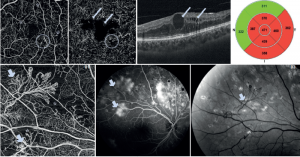Diabetes, Diabetic Retinopathy

Diabetic retinopathy is the most common cause of blindness at ages under 50 in Western countries and is caused by a sugar attack of retinal vessels. In particular, the inner wall of the vessels is destroyed, with the loss of their watertightness, accumulation of fluid in the retina resulting in the gradual destruction of photoreceptors with an accompanying decrease in visual acuity. The appearance of new incurable vessels causes with mathematical precision devastating and often irreversible complications for the eye such as membrane formation, vitreous hemorrhages, neovascularization or otherwise irritation of the iris with subsequent glaucoma (neovascular glaucoma) and ulcerate detachment of the retina.
Normal non-proliferative DR proliferative DR

DR : diabetic retinopathy
Risk factors
Known risk factors for diabetes mellitus
- Smoking
- Arterial hypertension
- Glycated hemoglobin (Hba1c) >6,0%
Diagnosis
To avoid the above, a fundoscopy of at least every year of all diabetics is necessary.
OCT angiography normal eye

OCT- and fluoroscein angiography of a patient with DR

Therapy
Regulation of diabetes mellitus and blood pressure, weight loss when needed, smoking cessation.
Retinal coagulation with ARGON-LASER
Injections of anti-VEGF agents or steroids in the vitreous body
Vitrectomy
Intravitreal injection

Prognosis
Good in case of early diagnosis and treatment.
Limited in case of macular edema or proliferative diabetic retinopathy and poor regulation of blood sugar, poor regulation of blood pressure as well as consumption of nicotine.

